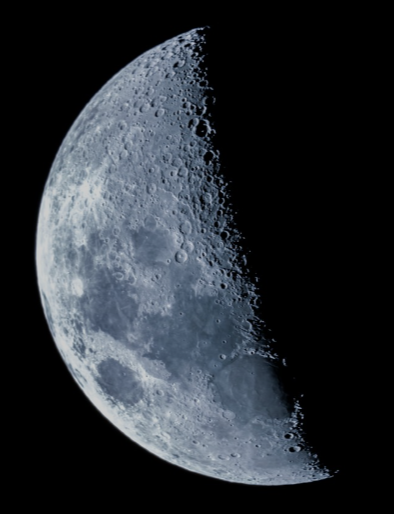Does India legally own the Moon’s South Pole? No. Could India legally own some of the Moon’s ice? Well, that’s complicated...
On August 23, 2023, the Vikram lander touched down just 370 miles from the moon’s south pole1, making India the fourth nation to successfully “soft land” an object on the lunar surface. India’s achievement marks a new milestone in terrestrial-lunar relations because this particular moon visitor originated from the Bay of Bengal as well as what the Chandrayann 3 Mission represents as the next small step toward the giant leap of lunar resource extraction.

The moon’s south pole is home to natural mountains and craters (and now a man-made lander and a rover) as well as H2O ice, which humans could, one day, use to produce drinkable water, breathable air and even combustible rocket fuel2.
This is a brief launch into the development of lunar property interests and suggests that the historical prejudice against exclusive ownership interests in space may be an insufficient framework for thinking about lunar ice and other celestial resources.
Does India Own The Moon’s South Pole?
For all the success of the Chandrayann-3 Mission, India does not own any portion of the moon. The lack of any property interest is not a failure of intent, execution or instrumentation.
No matter how far the Pragyan roves, or what other visitors, robotic or biological, make the 238,855 mile excursion, by popular consensus, the Moon is simply not “ownable.”
Under Article II of the 1967 Outer Space Treaty, which India and 113 other nations have signed, “Outer space, including the moon and other celestial bodies, is not subject to national appropriation by claim of sovereignty, by means of use or occupation, or by any other means3.” In other words, the United Nations places the Moon, Jupiter’s rings, Halley’s Comet, the Sun, and every other star, planet and space rock in a separate legal category entirely.
From a property law perspective, if ownership is crudely defined as the right to exclude4, no one nation has the right under the Outer Space Treaty to kick any other party off the moon. In some sense, then, the moon might be considered “common property,” something akin to the high seas.
“Common” should not be confused with “collective” property, where “the community as a whole determines how important resources are to be used... through mechanisms of collective decision-making5.”
The Outer Space Treaty did not establish a committee to govern the moon. It simply asserted that the Earth’s sole natural satellite should be “free for exploration and use by all States without discrimination of any kind.”
Of course, international treaties of this sort are susceptible to fundamental legal critiques, especially on the question of enforcement. Who would have authority to bound in and resolve a dispute between, say, competing Indian and Russian moon colonies?
Nevertheless, widespread acceptance of the Outer Space Treaty and historic representations of states that have actually succeeded in landing their sovereign property (and even citizens) on the moon combine to make it clear that neither India nor any other space-voyaging sovereign understands itself as having a unique property claim to the moon.
While certain, imaginative, Earth-bound individuals have attempted at various times to “gift” the moon (including, allegedly, Prussian King Frederick the Great in 17566), under the United Nations framework, no number of crash landings, robotic explorations, planting of flags, or hitting of golf balls can create an exclusive ownership interest.
Can India Own The Moon’s Ice?
Notable among the language of the original treaty is the word “use” (as distinct from “exploration”), the inclusion of which speaks to the recognition, even in 1969, that humans might one day harvest resources beyond our native planet.
In 2018, India’s Chandrayaan-1 spacecraft, carrying NASA’s Moon Minerology Mapper, definitely detected ice on the Moon’s surface (specifically in craters at the south pole). Since then, “moon ice” has been targeted as the first extra- terrestrial resource that humans may be able to harness (excluding of course solar energy, the tides, and the easement of orbital fields for our increasing constellation of satellites).
From melting a lunar ice cube for the refreshment of the moon’s next human visitors, it is not hard to imagine the jump to mining asteroids for precious metals (and companies such as AstroForge have done much more than imagine).7
However, while the resource possibilities may be plentiful and the technology advances rapid, the corresponding legal framework has been much slower to develop.
The 1979 “Agreement Governing the Activities of States on the Moon and other Celestial Bodies” recognized “the benefits which may be derived from the exploitation of the natural resources of the moon” but stressed that “neither the surface nor the subsurface of the moon, nor any part thereof or natural resources in place, shall become property of any State, international intergovernmental or non- governmental organization, national organization or non-governmental entity or of any natural person.”
The so-called “Moon Agreement” has not been well received. Only 22 states have signed (including India, but not including the United States, Russia or China) and, just this year, Saudi Arabia submitted notice of withdrawal — the first state to withdraw from any United Nations space treaty.8
Meanwhile, the United States has started to advance its own proposals, aiming to incentivize private investment in space while still professing adherence to the Outer Space Treaty. Along with Japan, the United Arab Emirates, and Luxembourg, the U.S. has passed legislation permitting private ownership of extracted space resources.9
The U.S. Commercial Space Launch Competitiveness Act provides that, ‘‘A United States citizen engaged in commercial recovery of an asteroid resource or a space resource . . . shall be entitled to any asteroid resource or space resource obtained, including to possess, own, transport, use, and sell the asteroid resource or space resource obtained in accordance with applicable law, including the international obligations of the United States.’’
Following on this sentiment, the U.S. Artemis Accords (promulgated in 2020 and already signed by 28 countries, including India)10 hold that “the extraction of space resources does not inherently constitute national appropriation under Article II of the Outer Space Treaty” and that legal instruments relating to space resources should be “consistent with” such treaty.
To arrive at private entitlement without passing through national appropriation would seem to rely on a jurisprudential map where private property rights float on a legal “island” independent of state sovereignty.
Politicians in Washington D.C. probably do not view themselves as “bequeathing” the right to harvest moon resources as they might drilling rights in the Alaska Arctic National Wildlife Refuge.
Yet the Outer Space Treaty clearly states that “activities of non-governmental entities in outer space, including the Moon and other celestial bodies, shall require authorization and continuing supervision by the appropriate State party to the Treaty.”
How can a state effectively exercise authority with respect to assets over which the state itself recognizes no exclusive claim? Or what if the state itself becomes a customer for the privately-extracted resource? Does that amount to back-door appropriation?
NASA has already announced its intent to purchase moon soil from commercial operators.11 The Artemis Accords gloss over these apparent inconsistencies and wrap without any specific proposal, merely a call to “further develop international practices and rules applicable to the extraction and utilization of space resources,” echoing the Moon Agreement’s exhortation to establish an “international regime, including appropriate procedures, to govern the exploitation of the natural resources of the moon as such exploitation is about to become feasible.”
Conclusion
We have rocketed past the “about to become feasible” stage, and now lunar commercialization is here. Whatever legal framework that develops will need to seriously address the question of property rights — the realistic default is arguably not communal ownership, but seizure and occupation, irrespective of state sanction.12
Rather than burying their heads in the lunar regolith, governments should embrace opportunities to incentivize private enterprise, which to a certain extent presupposes the possibility of private property rights. India’s private space economy is already $6 billion (four times greater than the budget of India’s state space agency)13, with 140 registered space-tech startups14.
While government contracts will remain a primary economic motivator, private enterprise should rightfully expect to have more and more direct participation (see, e.g., satellites and launch vehicles) — even on the moon.
Looking beyond Chandrayann-3, NASA and U.S. private industry is publicly positioned to take the next step toward “harvesting” moon ice. Intuitive Machines, Honeybee Robotics, INFICON and others15 are working together on a mission to mine at the moon’s south pole.
NASA heralds the Polar Resources Ice Mining Experiment-1 as “the first in-situ resource utilization demonstration on the Moon.” And, after that?
Mankind’s much-awaited return16, which could, in theory, feature a celebratory moon water toast. Whichever nation or private actor makes the next step after that, the resource-driven march forward certainly will not halt at H2O extraction. Helium-3, the isotope carried by solar wind, is repelled by Earth’s magnetic field but deposited on the lunar surface.17

As valuable as it is scare on Earth, the abundance of Helium-3 on the moon could be the key to nearly limitless nuclear energy free of radioactive waste, while also unlocking opportunities in other strategic sectors.
Whether via ice extraction permits, crater leases, solar panel installation licenses, or other legal instruments, the application and adaptation of developed property principals will play an important role in our relationship with the moon, space, and what we find there — including each other.
Curt Blake, Senior Contributor to SatNews Publishers, is Senior Of Counsel at Wilson Sonsini Goodrich & Rosati. He is an attorney and senior executive with more than 25 years of experience leading organizations in high-growth industries—and over 10 years as CEO
of Spaceflight, Inc.—at the forefront of the New Space revolution. Curt has extensive expertise in strategic planning, financial analysis, legal strategy, M&A, and space commercialization, with deep knowledge about the unique challenges of New Space growth and the roadmap to success in the that ecosystem.

Peter Bratton is a Senior Associate at Wilson Sonsini Goodrich & Rosati. He has extensive, cross-border experience advising private and public companies, venture capital and private equity funds, underwriters and lenders in a range of financings, M&A transactions, and complex corporate governance matters. In particular, Peter advises venture- backed companies and their investors at all stages of growth, including formation, funding, and exit.
References
1www.nytimes.com/2023/08/23/science/chandrayaan-3-india-moon-landing.html
2www.science.org/content/article/moon-may-hold-much-more-water-we-think
3www.unoosa.org/oosa/en/ourwork/spacelaw/treaties/outerspacetreaty. html#:~:text=Article%20II,or%20by%20any%20other%20means.
4,5According to one school of thought, “The right to exclude is usually seen as the key to ownership, even if it is one among many other rights and legal relations that property comprises. It is the aspect of ownership that has the greatest impact on others.” Stanford Encyclopedia of Philosophy plato.stanford.edu/entries/property/
6www.rmg.co.uk/stories/topics/who-owns-moon
7www.bloomberg.com/news/articles/2023-01-24/asteroid-mining-startup-astroforge-plans-first-platinum-refining-space-missions#xj4y7vzkg
8www.mcgill.ca/iasl/article/moon-agreement-hanging-thread
9cjil.uchicago.edu/online-archive/who-dares-wins-how-property-rights-space-could-be-dictated-countries-willing-make
10www.space.com/artemis-accords-explained
11www.theguardian.com/science/2020/sep/11/nasa-moon-mining-private-companies
12www.britannica.com/topic/property-law/Property-law-and-the-Western-concept-of- private-property
13www.nytimes.com/2023/08/23/science/chandrayaan-3-india-moon-landing.html
14www.nytimes.com/2023/07/04/business/india-space-startups.html
15www.nasa.gov/press-release/nasa-selects-intuitive-machines-to-land-water-measuring- payload-on-the-moon; www.nasa.gov/feature/how-will-we-extract-water-on-the-moon-we- asked-a-nasa-technologist-episode-47
16ru.usembassy.gov/biden-is-committed-to-nasas-artemis-program-for-the-moon-and- beyond/
17www.popularmechanics.com/space/moon-mars/a235/1283056/


